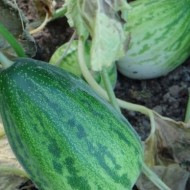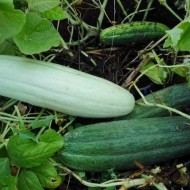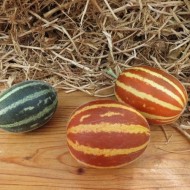What is cucumber and how to grow it outdoors
Content
- 1 What is ogurdynya
- 2 Video "How to grow a cucumber"
- 3 Useful and nutritional properties of the culture
- 4 Popular varieties of cucumber
- 5 Advantages and disadvantages
- 6 Features of growing cucumbers
- 7 The main diseases, pests and methods of dealing with them
- 8 Harvesting and storage rules
- 9 Recommendations for use
- 10 Reviews of summer residents
What is ogurdynya
The hybrid was born in Central Asia, it belongs to the Pumpkin family. As the crop matures, it has the properties of a cucumber, and readiness to eat is due to a change in color and taste, reminiscent of a melon. So a new type of fruit plant, bred by breeders, appeared - gherdin. Until the vegetable is ripe, it is used to fill salads, and the harvested unripe crop is preserved for the winter in the form of pickles. The ripe sweet fruit is used as desserts, it is also covered as a jam.
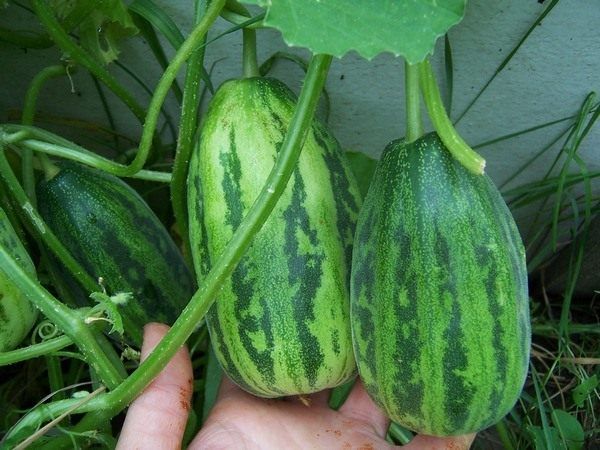
Video "How to grow a cucumber"
From this video you will learn how to grow a cucumber on your site.
Useful and nutritional properties of the culture
Such a vegetable is referred to as low-calorie foods, because 100 g of the fruit contains 38 kcal. The nutritious pulp, which is 90% water, has a large amount of beneficial microelements. It includes:
- pectin, nectarine;
- cellulose;
- proteins;
- organic acids, mineral salts;
- starch.
The ratio of useful elements depends to a large extent on the variety of the cultivated crop. In terms of taste, the plant resembles a cucumber in the early stages of ripening, and a ripe fruit acquires taste sensations from banana to peach.
Popular varieties of cucumber
Breeders have bred hybrids, the fruits of which reach 3 kg. There are more than 15 varieties that differ in taste and other properties. They have early maturity, productivity, resistance to cold and disease:
- Fasano;
- Improved;
- Special;
- New;
- Caramel;
- Green;
- White;
- Banana;
- Pineapple;
- Alexandria.
- Cucumber fruits can reach 1 kg
The general favorite, according to most gardeners, is Manduria. The fruits of this variety reach 1 kg, they are very juicy. The change in palatability as it ripens makes it exotic, especially at the first taste sensations. Another popular variety is Orenburg gourd. Dark green fruits 12 cm long can be removed in the middle of summer and used as a salad or canned. In mid-August, the vegetable fully ripens, more than a dozen yellow two-kilogram juicy fruits are obtained from one bush.
Advantages and disadvantages
When breeding this vegetable, breeders tried to take the maximum amount of positive qualities from crossed cucumbers and melons. As a result, ogurdynia has the following advantages:
- unpretentiousness;
- versatility when using fruits (both for pickles and desserts);
- good taste;
- high productivity;
- long fruiting period;
- early maturity;
- a large number of nutrients.
The benefits of this vegetable for the body are considerable: micro- and macroelements of the pulp help in the treatment of anemia, stimulate the outflow of bile, remove toxins and help restore metabolism. In addition, cucumber fruits have antioxidant properties.
Not a single vegetable can do without flaws. This hybrid is no exception:
- inconvenience of transportation;
- short shelf life of fresh fruits;
- a great tendency to disease.
Features of growing cucumbers
An unpretentious hybrid requires the same attention when planting and caring as cucumbers. The warm dry climate of the middle latitudes is favorable for the construction of such a culture. Depending on the location - from the Stavropol Territory to the Moscow Region - different varieties are selected.
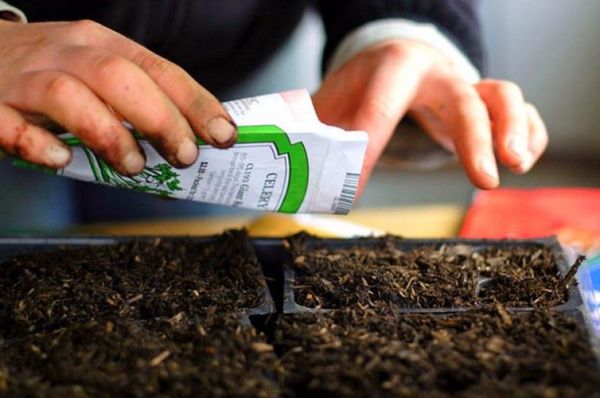
Optimal timing for growing
The hybrid is planted in open ground in the second half of May. This allows you to protect the culture from possible frosts in May, which sometimes make themselves felt in the first days of this warm month. In order for the seeds to sprout by this time, seedlings begin to grow after April 15–20, which allows you to get a harvest at an early date. Timely planting makes it possible (regardless of the type of hybrid) to collect fruits before the first frost.
Site selection and site preparation
In order to avoid cross-pollination, when determining the site, take care that related melons such as pumpkin or squash are not planted nearby. The soil for planting should be loose, and its properties should allow it to retain moisture as long as possible. Potassium sulfate and saltpeter are used as fertilizers.
Sowing seeds
The cold-resistant properties of the hybrid will not save it from possible frost, therefore, in regions remote from the southern regions, it will be acceptable to grow seedlings with subsequent planting on a garden bed. As a planting container, cups or small boxes are used, which are filled with peat soil, then seeds are planted to a depth of no more than 2 cm.
Rules for the care and planting of seedlings
Containers with seeds are placed in a warm, well-lit place. After 4–6 days, the seedlings sprout. The soil must be monitored and periodically watered abundantly. In the room where the seedlings are located, drafts are undesirable, and the room temperature is maintained at 18–20 ° C. After 30–35 days, the seedlings are transplanted into open ground.
Watering and feeding modes
The unpretentiousness of the hybrid and the tendency to bacterial diseases require measured periodic moistening of the soil, and the seedlings should be planted in such a way that the soil is ventilated and available for loosening. Top dressing is done when the first fruits appear with mullein or chicken droppings. Early enrichment of the soil with nutrients will lead to a greater development of the stem system, therefore, the moment the ovaries appear is fundamental when fertilizing the soil.
Weeding and loosening
Removing weeds around the bush is a prerequisite for growing a hybrid. It is carried out carefully so as not to damage the stems and leaves of the cucumber. After abundant watering or rain, the soil is loosened so that a crust does not form, which prevents the enrichment of the root system with oxygen.
Bush formation
In order for the culture to produce medium-sized fruits and develop correctly, pinching is used. It is performed over the fifth leaf of the main stem, and the lateral shoots - over 7 or 8 leaves. This will allow the required number of full-fledged ovaries to form. When the fruits are tied on the lateral processes, the pinching of these shoots is performed at the level of 2 or 3 leaves. The lateral stems touching the ground are buried in, providing more growth of the root system.

The main diseases, pests and methods of dealing with them
The tendency of a hybrid to fungal diseases requires proper attention and proper care. The most common troubles for cucumbers are bacterial or root rot. To reduce the likelihood of infection of the culture and grow a full-fledged hybrid, the following preventive measures are performed:
- change landing site annually;
- comply with all agrotechnical recommendations for the cultivation of a particular variety;
- periodically treat the plant with fungicides containing copper;
- the affected parts of the bush are cut off, then burned;
- when root rot is detected, the bush is removed along with the roots, and the place where it grew is treated with copper sulfate.
Harvesting and storage rules
The versatility of the crop allows you to start harvesting early and use the hybrid as a salad. At this stage, the fruits have a tough crust that will protect the vegetable during transport. When fully ripe, the cucumber becomes softer, and the crust becomes thinner. This is important to consider when transporting, especially over long distances.
In a cool place at temperatures from 0 to +5 ° C and good ventilation, the fruits can retain their taste for 1.5–2 months.
Recommendations for use
The exotic nature of the vegetable makes it possible to prepare salads, pickles and snacks from fruits at an early stage of ripening. And the specific properties of the ripe hybrid make it possible to use the finished product in the form of a dessert, as a separate dish or preservation (compotes, jam). In addition, the sweet fruit is consumed in the form of candied fruits and dried slices, providing the table with useful elements throughout the year.
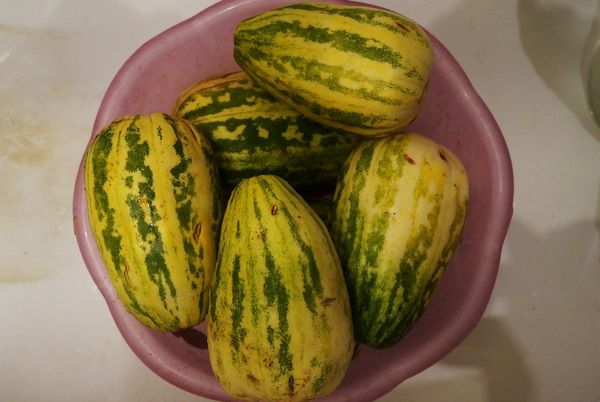
Reviews of summer residents
Most gardeners who have tried the melon culture for the first time are very surprised by the unique possibilities of using the hybrid in cooking. Especially surprising, according to gardeners, is the taste of melon, accompanied by pineapple or banana aroma, depending on the type of plant.
“Back in the Soviet years I tried to plant a hybrid, which was considered a curiosity, and I was very pleased. Then it was somehow forgotten, lost. Now, thanks to the Internet, I will grow again. A very tasty and versatile vegetable! "
“Last year I tried to plant it - everything worked out. As a cucumber in my family, this fruit has not become popular, perhaps because ordinary cucumbers are tastier or more familiar. But everyone liked the sweetness and aroma, even the neighbors. We will also plant this this year ”.
Using the achievements of breeders, summer residents grow unique and exotic crops. However, when purchasing this or that hybrid, one should take into account the recommendations and climatic adaptability of the vegetable to the planting area.

